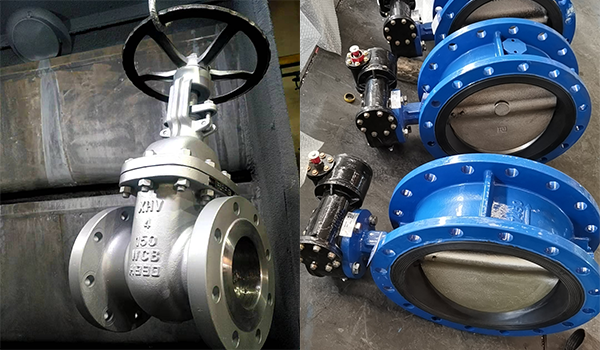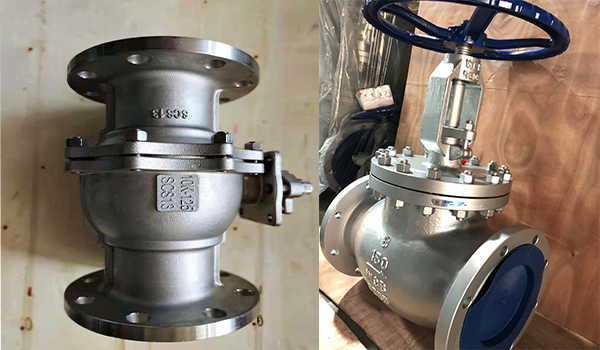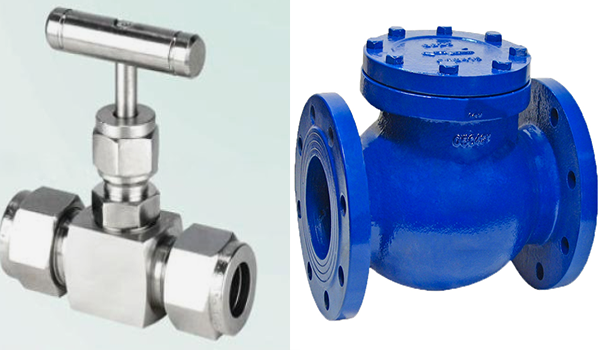- Gate valve
-
- DN1000 Extension stem double flange soft seal gate valveDIN F4 resilient seated gate valveDN450-1200 Resilient Seated Gate ValveDIN F5 resilient seated gate valveSocket connection soft seal gate valveUnderground cap soft seal gate valveBS5163 rising stem soft seal gate valveHard seal gate valveAPI slab Gate ValveStainless steel flange gate valveWafer knife gate valvePneumatic gate valveSoft seal gate valveExtension stem gate valveUL/FM fire protection groove ends gate valveRising stem forged steel gate valvecarbon steel gate valveStainless steel threaded gate valveDIN soft seal gate valveANSI soft sealing gate valve 200PSICast iron gate valveBS resilient seated gate valve
- Butterfly valve
-
- DN900 pneumatic triple eccentric hard seal butterfly valveD643H Triple Eccentric Butterfly ValveD343H Hard seal butterfly valveMulti standard EPDM seated butterfly valveSingle flange butterfly valveDN2000 Double eccentric butterfly valveFlange butterfly valveLug butterfly valveWafer butterfly valve with handleWorm gear operated butterfly valveWafer lined fluorine butterfly valveStainless steel wafer butterfly valveStainless steel flanged butterfly valveThree eccentric flange butterfly valvePneumatic flanged butterfly valvePneumatic wafer butterfly valveTriple eccentric butterfly valve wafer typeWafer butterfly valve ULC approvedInflatable seat butterfly valveHigh performance butterfly valveGrooved end butterfly valveElectric soft seal butterfly valveFlange fluorine lined butterfly valveHandle aluminum butterfly valveWorm Gear Aluminum Butterfly ValveFull PTFE lined butterfly valve wafer typeOne stem no-pin wafer butterfly valveMulti standard aluminum stem butterfly valveStainless Steel wafer Butterfly ValveAluminium handle operated lug butterfly valveLever Operated Flange Butterfly ValveButterfly valve stemButterfly valve discButterfly valve seat
- Ball valve
-
- DN1400 top-mounted eccentric semi-ball valveFlanged three-way ball valveFully welded ball valveNatural gas ball valveHigh platform flange ball valve1 PC ball valveFixed ball valvePTFE seat flanged ball valveMetal seat ball valveAPI 6D ball valve3 Piece ball valveFull Bore 3 way ball valve L-Port3 Way T-Port ball valve2PC Ball valve female thread stainless steel
- Globe Valve
-
- API Carbon Steel Globe ValveBellows Globe ValveStainless steel flange globe valveStainless steel thread S type globe valveStainless steel thread B type globe valveCast Steel Globe ValvePiston Globe ValveWCB Carbon Steel Globe Check Valveelectric motorized control stainless steel SS316 globe valveBrass Globe ValveCryogenic Globe valveHT200 Globe ValveThreaded Stainless Steel Globe ValveGG25 Globe ValveANSI API Cast Steel And Stainless Steel Globe valve
- Check valve
-
- Rubber seal check valveDN800 Slow closing check valveDN800 Rubber Disc Check ValveButterfly Buffering Check Valvecheck valve with counter weightSilent Check ValveWCB Swing check valveSwing Check ValveSingle Chip Check Valve H74WStainless Steel Wafer Check ValveSwing Start Check ValveFoot check valveAPI Swing Check ValveDIN Flange check valveSingle plate check valveLifting Check ValveBottom ValveHammer Diminish Noises Check ValveWafer Check ValveWafer dual plate check valve
- Control valve
-
- Static Balancing ValveCage Guided Sleeve Globe Control ValveDN1000 Piston Flow Regulating ValveDN1600 Electric Actuator Flow Regulating ValvePneumatic Flanged Butterfly ValvePneumatic Wafer Butterfly ValveAngle Seat ValvePneumatic gate valveElectric three-way control valveElectric sleeve control valve
- Water Meter
-
- Vertical Type Water MetersStainless steel threaded water meterPiston water meterPlastic water meterMore flow rotor dry water meterspiral vane flange water meterCI wotlman water meter with pulse outputLXCLG(R) Vertical removable element woltman cold (hot) water meterSingle flow rotor dry water meterPrepaid Token Water MeterElectromagnetic flowmeterRotary Piston Liquid Sealed Water MeterRotary Piston Liquid Sealed Water Meter
- Air valve
-
- Double ball exhaust valveDoubleair Air Valve SaudiDoubleair Air Valve Southeast AsiaDoubleair Air Valve South AmericaDouble Air ValveThreaded Air ValveSingle Air ValveTriple Functions Air ValveAutomatic Air Release ValveAutomatic release valveAutomatic exhaust valveComposite Exhaust Air ValveBrass exhaust valveDouble Ball Air Valve
- Pipe Repair & Coupling
-
- Flexible Multi-Function Pipe Coupling ZFJ-SSS Semi-Circle Pipe Repair Clamp SJW-HDuctile Iron Band Repair ClampStainless Steel Band Repair ClampDouble-Section Pipe Repair CouplingFolding Type Pipe RepairSingle-Section Multi-Function Pipe Coupling MF-SGear-Ring Type Multi-Function Pipe Coupling GR-SZBW Damping Corrugated Hose
- Dismantling Joint
-
- VSSJAFC(CC2F) Detachable Flange Transmission JointVSSJA-2(B2F) Double Flange Limited Expansion JointVSSJA-1(BF) Single Flange Limited Expansion JointVSSJA(AF) Flange Loose Expansion JointJGD-B Threaded Rubber JointZBW Damping Corrugated HoseKXT-S Flexible Dual-Spherical Rubber JointKXT Rubber Soft JointFlange Adaptor
Six types of valves and their applications
When you're looking for a new faucet or sink fixture, one of the first things you have to consider is what type of valves it has. Valves are at the heart of every plumbing system, so knowing about them can help you decide which products to buy and how much they cost. In this article, we'll look at six common types of valves and some applications where each might come in handy—and help you get a better sense of what type is best for your own needs!
Gate valves:
The gate valve is the most common type of valve used on pipelines. These valves are opened and closed by rotating a handle, which is connected to a disc that blocks the flow of fluid through the pipeline. Gate valves can be used in low-pressure applications where there is risk of contamination or explosion caused by pressure buildup. They're also commonly found in industrial facilities where there's a risk of explosions caused by flammable materials or gases being released into an open space; these substances need to be contained during transfer from one container into another.
A spring-loaded ball inside an actuator body transfers force from your hand to open and close the gate valve when you turn its handle 90 degrees clockwise or counterclockwise, respectively. Most modern gate valves use oil seals instead of packing glands (rubber gaskets) since they require less maintenance over time and don't lose their elasticity over years spent doing hard labor!

Butterfly valves:
The main benefit of butterfly valves over other types of valves is that they can be fully closed off at any time—even if there's pressure behind them—without any leakage whatsoever; this makes them especially useful for process applications like cooling towers where condensation needs to be tightly controlled before being made safe again by draining into an open channel below ground level (where it can evaporate without causing environmental damage).
Butterfly valves are used for low-pressure applications, such as air and liquid. They're not designed for use with steam or high pressure liquids.
Butterfly valves are used in industrial applications, such as chemical plants and power plants, where they control the flow of liquids and gases through pipes.
Butterfly valves were originally designed by British engineers in the late 19th century to regulate water flow through pipes in factories. They're still widely used today because they're compact, easy to operate manually, and offer precise control over fluid flow (which is important when dealing with dangerous chemicals).
Ball Valves:
Ball valves are the most common type of valve because they offer excellent control and a wide range of operating conditions. Ball valves can be used in both vertical and horizontal orientations, which makes them ideal for use in process industries that require pipes to be placed horizontally or vertically within vessels.
Ball valves may be fitted with either single-seated or double-seated bonnets depending on your needs. Single seated ball valves will allow you to turn them using only one hand while double seated ball valves will require two hands at all times due to their design, but this isn't necessarily a bad thing as it can help prevent accidental damage from occurring if someone has trouble turning the handle all the way off due to fatigue or other reasons such as arthritis pain etcetera."

Globe Valves:
Globe valves are typically used to control flow in a piping system and come in various sizes. The globe valve is made up of a disk and an attached stem, which are both connected to the body of the valve. The body houses the packing assembly and bonnet attachment threads that connect with other components of your piping system.
The disk is called either a bonnet or disk depending on who you ask—the difference between these two names comes down to how they're made. A bonnet is made from solid metal whereas disks are made from cast iron or ductile iron (a type of iron).
High-temperature, high-pressure media on the pipeline or device should be used on the shut-off valve. Such as thermal power plants, nuclear power plants, petrochemical systems of high temperature, high pressure pipeline.
Needle Valves:
Needle valve is a kind of valve that can be adjusted for a wide range of uses, such as cutting distance for flame cutting, the knob to adjust the flame temperature is a needle valve. Instrument needle valve is an important part of the instrument measurement piping system, mainly shut-off valves and ball valves, its function is to open or cut off the pipeline pathway with. Needle valve spool is a very sharp cone, like a needle into the valve seat, thus the name.
Needle valves are used to control the flow of a liquid or gas. A needle valve is very precise, so it's commonly used in medical equipment as well as chemical processes. The valves can also be used to regulate the temperature of an object.
Metal-to-metal sealed needle valves are available on piping systems or devices for high-temperature media in metallurgical systems, electric power systems, petrochemical installations, and urban heating systems. Low-temperature media piping systems and devices, it is appropriate to use the low-temperature needle valve with valve cover. The piping system of the catalytic cracking unit of the oil refinery can be selected with the lifting lever needle valve.

Check Valves:
It is important to note that check valves are not designed for preventing uncontrolled flow in pipes. They are designed specifically to prevent back flow of fluids in pipes or tanks.
Check valves come in many shapes and sizes, but they all have the same basic design: a spring-loaded ball bearing that is held against the valve seat by some kind of force (usually a small amount of vacuum). When this force is removed—for example, when pressure is applied from one side—the ball will move out from under its seat allowing fluid through. If pressure from only one direction exists at any given time, then this type of valve will not allow any flow through it until an equal amount of pressure reaches both sides of the opening on either end (hence its name).







